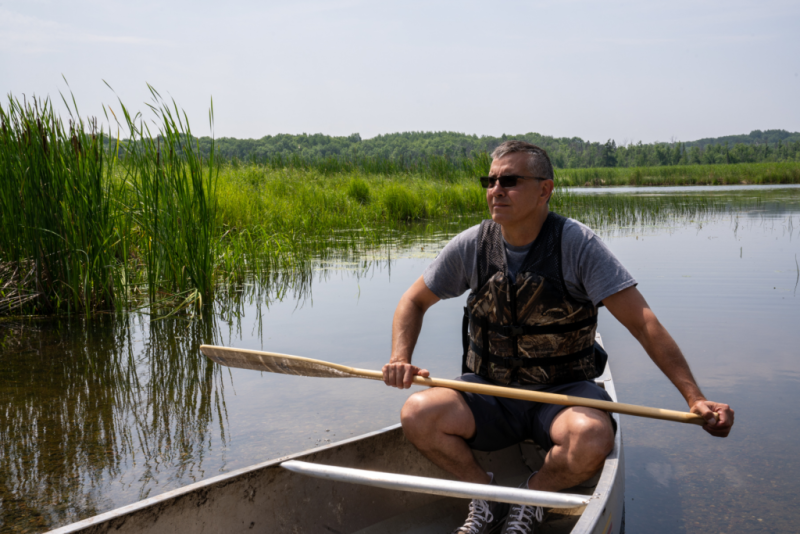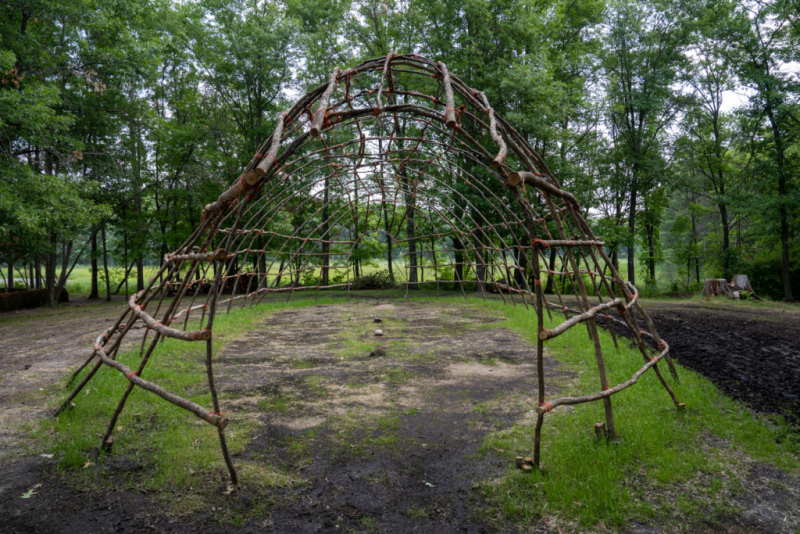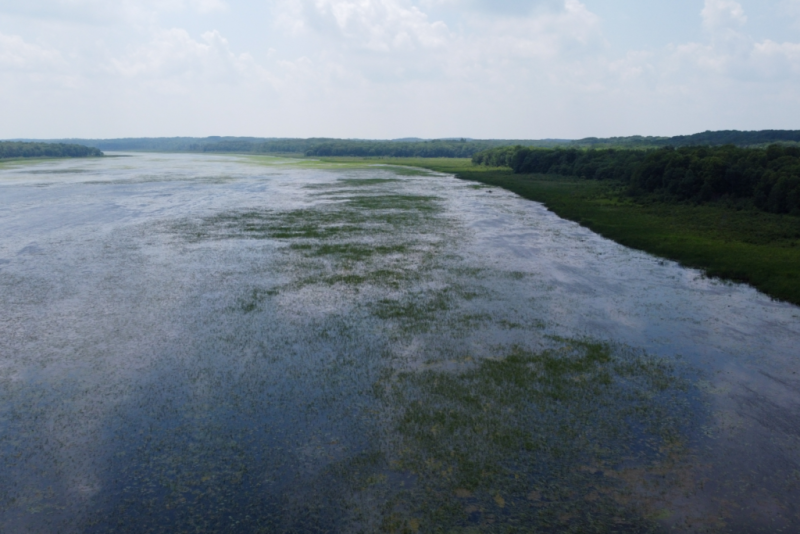Survival of Wild Rice Threatened by Climate Change, Increased Rainfall in Northern Minnesota
This article is part of a collaboration that includes the Institute for Nonprofit News, Borderless, Ensia, Grist, Planet Detroit, Sahan Journal and Wisconsin Watch, as well as the Guardian and Inside Climate News. The project was supported by the Joyce Foundation.
ONAMIA, MINN.—Todd Moilanen paddles gently through wild rice beds on Ogechie Lake, trying not to disturb a loon sleeping on its back on a nest of reeds a few feet away.
Moilanen, an enrolled member of the Mille Lacs Band of Ojibwe and the Band’s cultural resources director, delights in seeing resurgence of life on Ogechie Lake. For years, the small, shallow lake about 100 miles north of the Twin Cities was too deep for wild rice, or manoomin, as wild rice is called in the Ojibwe language.
Logging companies around the Rum River built the Buck More Dam in the 1930s, which kept water levels consistently over four feet—too high for manoomin.
Low water levels are critical for manoomin, a sacred crop for the Ojibwe people of the Great Lakes region. But climate change caused by the burning of fossil fuels is bringing more rain and flooding to Minnesota and the Upper Midwest, making harvests of wild rice less reliable.
For more than 70 years there was virtually no rice, and very little waterfowl and wildlife on Ogechie Lake. But the Mille Lacs Band worked with an engineering firm and the Minnesota Department of Natural Resources to modify the dam, and in 2015, they implemented a project to restore the lower level historically experienced on the lake, part of the Mille Lacs Band of Ojibwe Reservation and Minnesota’s Kathio State Park.
Eight years later, the effect is dramatic. The shallow lake brims with wild rice, which, as Moilanen paddles through in late June, is in its “floating-leaf” stage, where most stalks lie flat against the water’s surface and others are beginning to emerge above the waterline. Now, wildlife that feed on the wild rice are regular visitors.
Moilanen points out a wood duck skimming across the glassy surface and a large osprey swooping overhead. His canoe quietly passes the loon; the large black bird with a distinctive white band around its neck stirs awake and dives into the water.

“That’s the ecosystem that’s coming back,” Moilanen says.
Wild rice is a fickle aquatic grass that can be washed out by rising water levels, a growing trend in Minnesota, according to 128 years of state precipitation data. The grass seed, or grain, has been consumed by the Ojibwe and other Tribal Nations for centuries, and has garnered widespread appeal in the ubiquitous wild rice soup found on menus across Minnesota and the Upper Midwest.
Tribal, state, and federal governments are working to adapt to the changing environment to ensure manoomin lives on in Minnesota, which is home to more acres of natural wild rice than any other state in the country.
“We see the extremes more often now,” said Kelly Applegate, director of natural resources for the Mille Lacs Band of Ojibwe. “We see water levels that are really high at critical points when the rice is developing.”
For Tribal Nations of northern Minnesota, wild rice’s survival is not just about protecting the environment—it’s also about preserving a core part of their identity.
The Ojibwe of Minnesota and Wisconsin are Anishinabe people who originated in the woodlands of the northeast. According to traditional beliefs, the Ojibwe were told to move west until they found food growing on the water. They found it in the shallow lakes and rivers of northern Minnesota and Wisconsin, and it became a staple of their diet.
“The reason that we’re here is because of manoomin,” Moilanen says.
Warmer and Wetter
Minnesota’s climate is getting warmer and wetter. The 10 warmest and wettest years in recorded state history have all occurred in the past 25 years, according to the Minnesota Department of Natural Resources.
That change has brought a massive increase in large rainfall events. Since 2000, storms that produce more than six inches of rain have been occurring four times more often than in the 20th century, DNR data shows.
Record snowfall in Minnesota this winter, a sudden warmup in early spring, and a few heavy storms led to widespread flooding across the state earlier this year, prompting the capital city, St. Paul, to declare a flood emergency. In response, Governor Tim Walz signed a disaster assistance bill in April that moved $40 million, the largest amount ever, to an emergency account to help Minnesotans recover from flood damage.
Even small changes can meaningfully alter the environment. Since 2000, there has been a 65 percent increase in the number of rainfalls over three inches and a 20 percent increase in storms with more than one inch of rain.
The state is getting wetter as the climate warms, according to Minnesota Senior Climatologist Kenny Blumenfeld. The 2010s were a historically wet decade. The early 2020s have brought drought, but it is likely still the wettest among the state’s other bouts with drought, Blumenfeld said.
“When we get the heavy rains, it’s coming as hard as it ever has,” he said.
The current trend is dry periods between June and October, and really wet periods from November to April. But that can and likely will change, Blumenfeld said, adding that the warming atmosphere only promises more moisture, but it won’t necessarily be clear when that moisture will come.
Blumenfeld earned a PhD studying major storms in Minnesota, and said the frequency of such storms keeps growing.
More Water in Ricing Country
The Rum River watershed of central Minnesota, home to the Mille Lacs Band of Ojibwe, received an average of 28 inches of rain a year from 1895 to 2022, according to precipitation records the state began keeping in 1895. The rate has been rising by about half an inch per decade since 1980, according to state climate trend data.
But for the past 20 years, annual precipitation in the watershed has risen to an average of around 31 inches.
“It’s a huge deal because that water has to go somewhere,” Blumenfeld said.
The Little Fork River watershed, home to the Bois Forte Band of Chippewa, one of the seven sovereign Ojibwe nations in the state, is also getting wetter. The watershed has an average annual precipitation of 26 inches, which has been growing two inches per decade in the past 20 years. Last year was particularly wet, with nearly 35 inches of precipitation, which contributed to historic flooding.
Spring flooding in 2022 practically wiped out the entire wild rice crop on Nett Lake, said Chris Holm, ecological resources director for the Bois Forte Band of Chippewa. The shallow lake about 220 miles north of the Twin Cities near the Canadian border is a traditional ricing hub for the Bois Forte Band.
While cultivated wild rice that has been bred for specific qualities is farmed commercially in Minnesota, Tribal Nations often prefer its original form that grows naturally with little or no intervention in the lakes and rivers of northern Minnesota. Tribal members harvest the rice for personal use and for sale to the general public.
Wild rice is sensitive to water levels, particularly in June. Too much spring rain can wipe out beds before they can take root.
“If you have higher water levels, it takes more energy for the plant to grow up into the surface and leaf out where it can photosynthesize. So with high water levels, you have less plant growth, less manoomin harvest,” said Madeline Nyblade, a graduate student at the University of Minnesota pursuing a doctorate in hydrology.
Nyblade is part of Kawe Gidaa-naanaagadawendaamin Manoomin, or First We Must Consider Manoomin, a university research group that focuses on tribally driven questions around wild rice. Many of the questions the researchers received about climate change focus on water levels, she said.
The bigger storms Minnesota is now experiencing on a more regular basis also challenge the rice, especially late in the season. A violent storm with heavy rain and wind can knock rice off the stalks before it can be harvested in late August.
Applegate recalled a recent year where high water took out 90 percent of the rice beds for the Mille Lacs Band. Then in 2021, the opposite happened—a late summer drought prevented the harvest. The rice around Mille Lacs was tall and thriving, Applegate recalled, but with too little water, ricers couldn’t reach the patches by canoe to harvest the manoomin.
Rapid Change
Applegate, an enrolled Mille Lacs Band member who grew up in the area, has seen shifts from climate change. The moose have moved further north. The white birch trees are receding. And beds of manoomin that served his people for generations are more regularly being wiped out by high waters.
“As Anishinabe and tribal people, we depend on these wild plants for our food, medicines, craft materials—cultural objects made from plants. They’re a very integral part of our culture,” Applegate said.
Climate change is rapidly shifting where and how plants grow in Minnesota, and the pace is concerning to the Mille Lacs Band, he said.
Historically, Native people in the Great Lakes region could expect bountiful wild rice, according to Mike Dockry, an assistant professor with the University of Minnesota and a member of the First We Must Consider Manoomin Research Group. Dockty is an enrolled member of the Citizen Potawatomi Nation, a traditional ricing people of the Great Lakes region.
“It was growing on many, many more lakes than it is now, and tribes were free to move,” Dockry said.
Any one lake might have a bad harvest, but people could find another that was booming, he said. Settler-driven land use and large scale water system management geared toward agriculture has contributed to fewer bodies of water with wild rice.
Wild rice itself is well adapted for variability as an annual plant with seeds that can lie dormant for years if conditions aren’t right, and has genetically benefited from variability over time, Nyblade said. But land use systems like dams that created stagnant conditions prevented that in many water bodies, and now climate change is bringing variations such as warmer winters.
Disconnected from the traditional seasonal migration pattern by the United States’ reservation system that limits them to specific plots of land, Native people are left to focus on preservation and protection of traditional resources.
“How are we going to harvest these traditional plants if they move out of our area?” Applegate asked.
‘We Need a Break’
Up on Nett Lake, members of the Bois Forte Band of Chippewa are due for a good year. Flooding largely wiped out the wild rice crop in 2022.
“We need a break,” said Chris Holm, ecological resources director for the Bois Forte Band.
Historic flooding hit the Rainy River Basin in 2022. The area, straddling the U.S.-Canadian border, experienced heavy snow melt combined with large spring storms.
Holm has worked with the tribal natural resources department for 30 years. Most of the total crop losses for the Bois Forte Band have come in the past decade, he said. The Tribal Nation takes the rare step of insuring its wild rice crop through the United States Department of Agriculture (USDA). Claims are rare, but all three that have been filed in his tenure have come in the last decade, including in 2022.
This season, conditions looked poor again with a snowy winter, a late ice out—when winter ice melts on frozen lakes—and high water levels through May.
“We thought we were in trouble,” Holm said.
But the Bois Forte Band may get the break they need this year. An early summer dry spell appears to have salvaged the rice crop for now. The rice has good germination this season, Holm said.
But the increase in heavy thunderstorms makes Holm nervous. A big August storm can knock even the most promising rice off its stalks.
‘I Worry It’s Not Enough’
Ann Geisen, a lake wildlife specialist for the Minnesota Department of Natural Resources, specializes in shallow lakes where wild rice thrives. Based in Aitkin, north of Lake Mille Lacs, she covers seven wild rice-rich counties in Minnesota.
She’s noticed an increase in extremes in recent years that has brought less predictability and greater variability to wild rice harvests.
Geisen began working for the DNR in 2001, the same year the agency started managing lakes to help improve wild rice growth. That effort is mostly done by removing beavers and their dams to clear outlets—running water connecting lakes to other water bodies—for lakes with wild rice. Free of dams and other natural debris, water will spread across more lakes, lowering their levels.
Beaver dams are very effective at holding back water, to the point where removing a dam can lower lake levels by a foot. Good rice lakes are very shallow, so an extra foot of water on a four-foot lake is a huge percentage, Geisen said.
“We cannot control the weather, but we try to set the stage so that when there is a weather event the impact is reduced,” Geisen said.
The DNR and the Mille Lacs Band of Ojibwe are working together on improving conditions at Swamp Lake, located about 100 miles north of the Twin Cities. Manoomin once thrived there, but largely disappeared in the 1990s, when water levels got too high for rice.
Through historical records provided by locals and site visits, Band and Minnesota natural resources staff found the lake’s overgrown outlet channel. They hired a contractor to clear the channel in 2021. Thirty-five beaver dam removals later, the 6.5 mile channel was flowing without obstructions.
Suddenly the water had a place to go. Water levels on Swamp Lake dropped, and in August 2021, 10 wild rice plants were observed in the middle of the lake. While water levels were too high last season, Geisen said they’re hoping more rice will come this year.

If there’s not ample rice this year, the DNR and Mille Lacs Band plan to seed the lake with wild rice. They decided to try seeds sourced from a single nearby lake if Swamp Lake doesn’t replenish naturally, Geisen said.
Geisen is encouraged by these intervention success stories, but she knows the fight is lopsided. If the big storms that are becoming more common late in the season continue, it won’t matter if all the beaver dams were pulled—the rice will be mostly lost.
“I’m getting concerned that with climate change, it’s not enough,” she said.
Geisen is keeping her fingers crossed for this year, as conditions so far are favorable. That’s a sentiment echoed by the Bois Forte and Mille Lacs bands. The relatively dry summer has stabilized water levels after a major spring melt, and the rice is looking good in many parts of the state.
The Most Sacred Mashkiki
Paddling through the rice on Ogechie Lake, Moilanen is optimistic about this year’s harvest. As the Mille Lacs Band’s cultural resources director, he works to connect enrolled members with traditional practices, and takes out young ricers for their first harvest each year.

Dymanh Chhoun | Sahan Journal
He loves passing on the traditions and teaching others how to gather mashkiki, the word for medicine in the Ojibwe language. Manoomin is considered the most sacred mashkiki, with its use as a staple crop that sustained people during lean times and its connection to the Ojibwe origin story.
While Ogechie Lake’s water issues were mostly the result of a dam instead of rainfall, its management is a success story for manoomin, and proof of nature’s resiliency. For more than 70 years, high water levels caused by a dam aimed at boosting profits for loggers and farmers meant that just one percent of the lake had rice.
But the manoomin wasn’t gone—it was just dormant, waiting to rise again under the right conditions.
This year, manoomin covers 70 percent of the lake, and the stalks are beginning to break the surface as they reach towards the sun. With the rice comes all the life it can sustain—the lives of waterfowl and of the Anishinabe people.
“It goes so far beyond restoring wild rice,” Moilanen says. “It’s a whole lifecycle, a whole world is restored.”
Disclaimer: The copyright of this article belongs to the original author. Reposting this article is solely for the purpose of information dissemination and does not constitute any investment advice. If there is any infringement, please contact us immediately. We will make corrections or deletions as necessary. Thank you.







